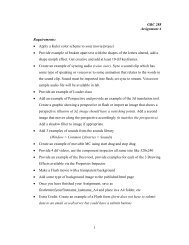Introducing Financial Accounting - CCSN Computer Graphics Program
Introducing Financial Accounting - CCSN Computer Graphics Program
Introducing Financial Accounting - CCSN Computer Graphics Program
You also want an ePaper? Increase the reach of your titles
YUMPU automatically turns print PDFs into web optimized ePapers that Google loves.
wiL27041_ch01_002-047.indd Page 22 10/4/10 7:12:40 PM user-f499 /Volumes/204/MHBR211/wiL27041_disk1of1/0073527041/wiL27041_pagefiles<br />
22 Chapter 1 <strong>Introducing</strong> <strong>Financial</strong> <strong>Accounting</strong><br />
A2<br />
Decision Analysis<br />
Compute and interpret<br />
return on assets.<br />
EXHIBIT 1.11<br />
Return on Assets<br />
flows, and statement of retained earnings (equity), while IFRS requires disclosures for the current and<br />
prior year. Still, the basic principles behind these two systems are similar.<br />
Transaction Analysis Both U.S. GAAP and IFRS apply transaction analysis identically as shown<br />
in this chapter. Although some variations exist in revenue and expense recognition and other principles, all<br />
of the transactions in this chapter are accounted for identically under these two systems. It is often said<br />
that U.S. GAAP is more rules-based whereas IFRS is more principles-based. The main difference on the<br />
rules versus principles focus is with the approach in deciding how to account for certain transactions.<br />
Under U.S. GAAP, the approach is more focused on strictly following the accounting rules; under IFRS,<br />
the approach is more focused on a review of the situation and how accounting can best reflect it. This difference<br />
typically impacts advanced topics beyond the introductory course.<br />
<strong>Financial</strong> Statements Both U.S. GAAP and IFRS prepare the same four basic financial statements.<br />
To illustrate, a condensed version of Nokia’s income statement follows (numbers are in euros<br />
millions). Nokia is a leader in mobile technology, from smartphones to mobile computers. Similar condensed<br />
versions can be prepared for the other three statements.<br />
NOKIA<br />
Income Statement (in € millions)<br />
For Year Ended December 31, 2009<br />
Net sales . . . . . . . . . . . . . . . . . . . . . . . . . . . . . . . . . . . . . . . 40,984<br />
Cost of sales . . . . . . . . . . . . . . . . . . . . . . . . . . . . . . . . . . . . 27,720<br />
Research, selling, administrative, and other expenses . . . . . 12,302<br />
Taxes . . . . . . . . . . . . . . . . . . . . . . . . . . . . . . . . . . . . . . . . . . 702<br />
Net income (profit) . . . . . . . . . . . . . . . . . . . . . . . . . . . . . . . 260<br />
Decision Analysis (a section at the end of each chapter) introduces and explains ratios helpful in decision making<br />
using real company data. Instructors can skip this section and cover all ratios in Chapter 13.<br />
Return on Assets<br />
A Decision Analysis section at the end of each chapter is devoted to financial statement analysis. We organize<br />
financial statement analysis into four areas: (1) liquidity and efficiency, (2) solvency, (3) profitability,<br />
and (4) market prospects — Chapter 13 has a ratio listing with definitions and groupings by area. When<br />
analyzing ratios, we need benchmarks to identify good, bad, or average levels. Common benchmarks include<br />
the company’s prior levels and those of its competitors.<br />
This chapter presents a profitability measure: return on assets. Return on assets is useful in evaluating<br />
management, analyzing and forecasting profits, and planning activities. Dell has its marketing department<br />
compute return on assets for every order. Return on assets (ROA), also called return on investment<br />
(ROI), is defined in Exhibit 1.11.<br />
Net income is from the annual income statement, and average total assets is computed by adding the beginning<br />
and ending amounts for that same period and dividing by 2. To illustrate, Best Buy reports net income<br />
of $1,317 million for fiscal year 2010. At the beginning of fiscal 2010, its total assets are $15,826 million<br />
and at the end of fiscal 2010, they total $18,302 million. Best Buy’s return on assets for fiscal 2010 is:<br />
Return on assets 5<br />
Return on assets 5<br />
Net income<br />
Average total assets<br />
$1,317 million<br />
5 7.7%<br />
($15,826 million 1 $18,302 million)y2<br />
Is a 7.7% return on assets good or bad for Best Buy? To help answer this question, we compare (benchmark)<br />
Best Buy’s return with its prior performance, the returns of competitors (such as RadioShack, Conn’s, and<br />
Rex Stores), and the returns from alternative investments. Best Buy’s return for each of the prior five years<br />
is in the second column of Exhibit 1.12, which ranges from 7.0% to 10.8%.









